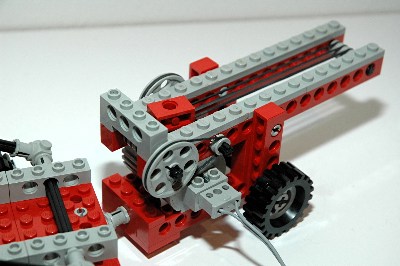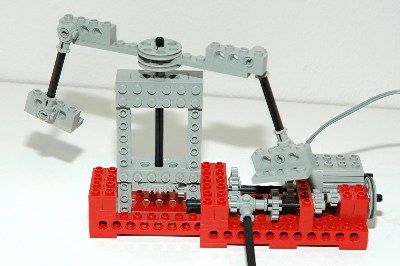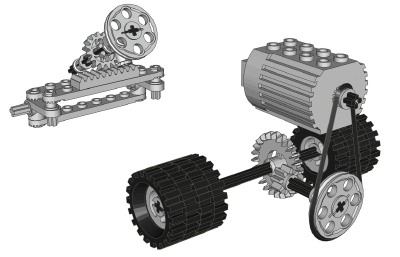1st Model: Car
with Conveyor
|
This
little car seems to be pulling some mining equipment for some reason.
The front wheels can be steered using a wheel in the cabin. The
wheel drives an 16 tooth pinion gear at an angle. The pinion
drives the steering rack. The
steering mechanism itself uses
control arms and toothed links.
The trailer uses the motor to drive a pulley. This pulley, in
turn, uses a belt to reduce the speed and drive another pulley.
This final pulley drives a series of 4 long rubber belts which act as a
conveyor to haul pieces along the length of the trailer.
Why? Who knows, but it is the only set with these long rubber
bands.
|



Click for an animation of
the
steering in motion.
Click for an animation of
the conveyor in motion.
|
2nd
Model: Compactor
|
What
is this thing? Good question. I don't know the
answer. It is a bit like an oscillating floor sander, or like a
heavy tool used to vibrate and smooth concrete. It is most likely
a tamper or compactor for site preparation. It might also be
used to drive away vermin!
The motor drives a belt which is not
geared down so it rotates at very high speed. The output pulley
has a 2L Technic brick attached to it which causes it to be
imbalanced. This results in a high speed vibration of the whole
model.
The vibration in the animation is fake. Actual motion is far too
fast to capture with stop motion, and even full motion video would have
trouble. This is more of a "buzz" than an oscillation.
|

Click for an animation of
the compactor in motion.
|
3rd
Model: Crane
|
This
small mobile crane slews the boom and retracts the cable.
The motor drives a cable drum through a belt and a set of 8 and 24
tooth gears. The cable moves quite quickly.
The cabin can slew using a crank and a set of 8 and 24 tooth
gears. There is no turntable here, the whole thing simply rotates
on an axle.
The boom is at a fixed angle.
|
|
4th
Model: Centrifugal Force Machine
|
Now
here is something really unusual, a bit of a science experiment.
A rotor supports two masses on pivoting arms. The faster the
rotational velocity of the rotor, the higher the angle of the masses
due to centrifugal force (slow speed on the left, high speed on the
right). No doubt some of you will complain that there is
technically no such thing as centrifugal force but actually a
centripetal
acceleration. You'd be right, but that is beyond the scope of
this web page.
A simple transmission is used to change speeds. A motor drives
the first axle through a belt and pulley. This axle drives
another at the same speed via a pair of 8 tooth spur gears. This
second axle rotates at a fixed speed, but it can drive the third axle
at two different speeds based on its position. If moved to the
left, an 8 tooth gear drives a 24 tooth gear. If moved to the
right, a 16 tooth gear drives another 16 tooth gear. So there is
a 3X difference between these two positions. A final set of 8 and
24 tooth gears drive the rotor.
The stop motion animation is not fast enough to show the rotation, but
frames were taken at a constant interval as the machine slowed
down. You can see the "arms" relaxing as the speed decreases.
|


Click for an animation of
the machine at different speeds.
|
5th
Model: Electric Gate
|
This
electric gate is the only model which does not use the motor, and also
the only model to use the new worm gear. A crank drives the worm
gear which rotates a 24 tooth spur gear, lifting the gate, and
resulting in 24:1 gear reduction in one stage.
The use of a worm gear results in a system which cannot be backdriven
(because the axial friction is higher than the
backdriving torque due to the screw pitch angle) which allows the gate
to be supported so that it does not fall under its own weight.
|

Click for an animation of
the gate in motion.
|
6th
Model: Car
|
This
small car, which looks like a Jeep or Land Rover, has steering and a
motorized rear axle.
The front wheels can be steered using a wheel in the cabin. The
wheel drives an 8 tooth pinion gear. The pinion drives the
steering rack. The
steering mechanism itself uses
control arms and toothed links.
A motor mounted on the rear drives a pullley via a belt. A set of
8 and 24 tooth gears transfer the torque to the rear axle.
This model could use a bit more gear reduction. The vehicle tries
to go faster than the motor can really handle.
|
|













